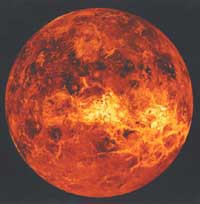Venus is often called Earth's twin because the two planets are close in size, but that's the only similarity. The thick clouds that cover Venus create a greenhouse effect that keeps it sizzling at 864°F. Venus, named after the Roman goddess of loveand beauty, is also known as the “morning star” and “evening star” since it is visible at these times to the unaided eye. Venus appears as a bright, white disk from Earth.
Venus
 courtesy of JPL/Caltech/NASASize: About 650 miles smaller in diameter than EarthDiameter: 7,519 miles (12,100 km)Surface: A rocky, dusty, waterless expanse of mountains, canyons, and plains, with a 200-mile river of hardened lavaAtmosphere: Carbon dioxide (95%), nitrogen, sulfuric acid, and traces of other elementsTemperature: Ranges from 55°F (13°C) to 396°F (202°C) at the surfaceRotation of its axis: 243 Earth daysRotation around the Sun: 225 Earth daysYour weight: If you weigh 100 pounds on Earth, you would weigh 88 pounds on Venus.Distance from Earth: At its closest, Venus is 26 million miles (41,840,000 km) awayMean Distance from Sun: 67.24 million miles (108.2 million km)Satellites: 0Rings: 0
courtesy of JPL/Caltech/NASASize: About 650 miles smaller in diameter than EarthDiameter: 7,519 miles (12,100 km)Surface: A rocky, dusty, waterless expanse of mountains, canyons, and plains, with a 200-mile river of hardened lavaAtmosphere: Carbon dioxide (95%), nitrogen, sulfuric acid, and traces of other elementsTemperature: Ranges from 55°F (13°C) to 396°F (202°C) at the surfaceRotation of its axis: 243 Earth daysRotation around the Sun: 225 Earth daysYour weight: If you weigh 100 pounds on Earth, you would weigh 88 pounds on Venus.Distance from Earth: At its closest, Venus is 26 million miles (41,840,000 km) awayMean Distance from Sun: 67.24 million miles (108.2 million km)Satellites: 0Rings: 0 Return to Planet Index


